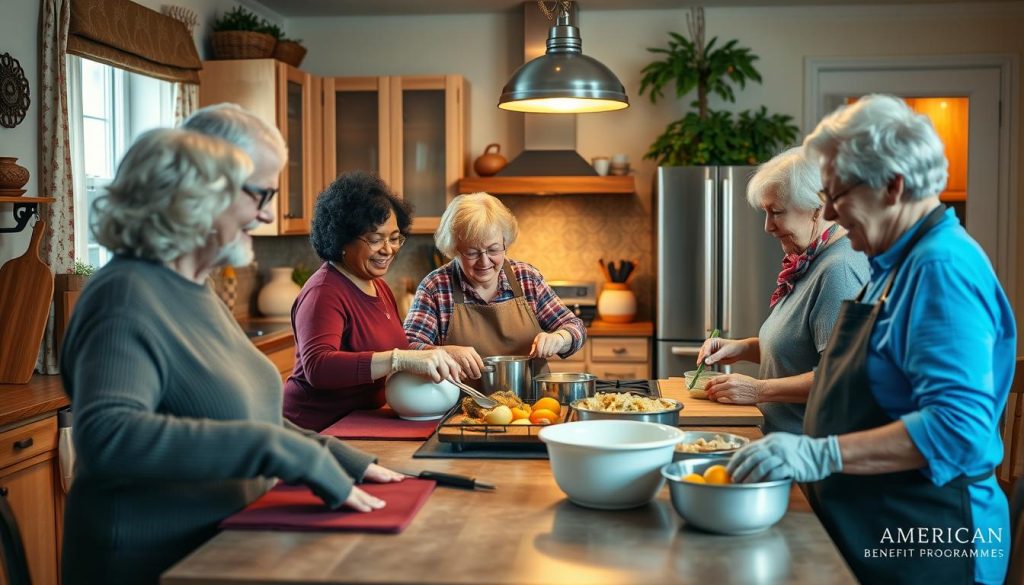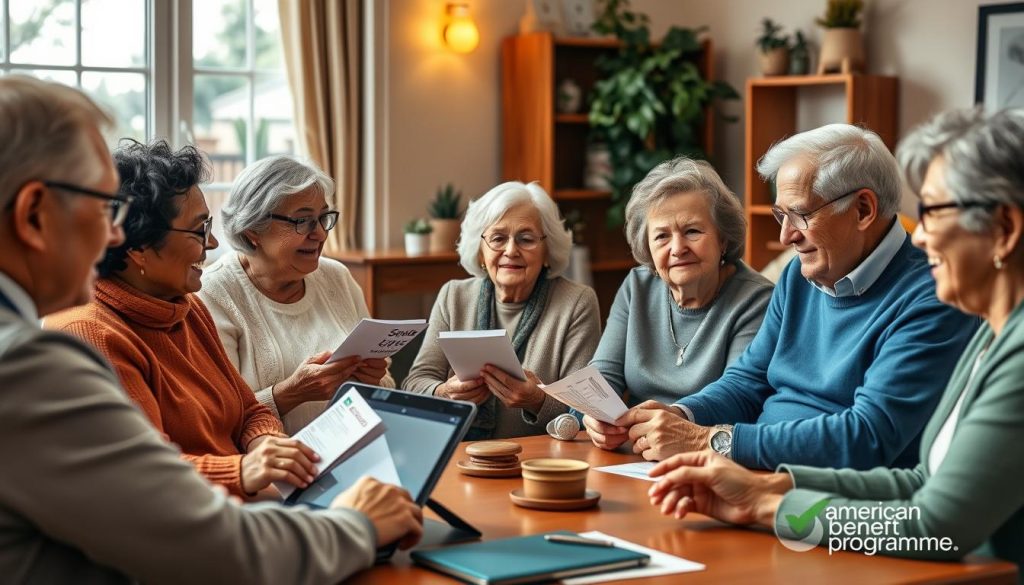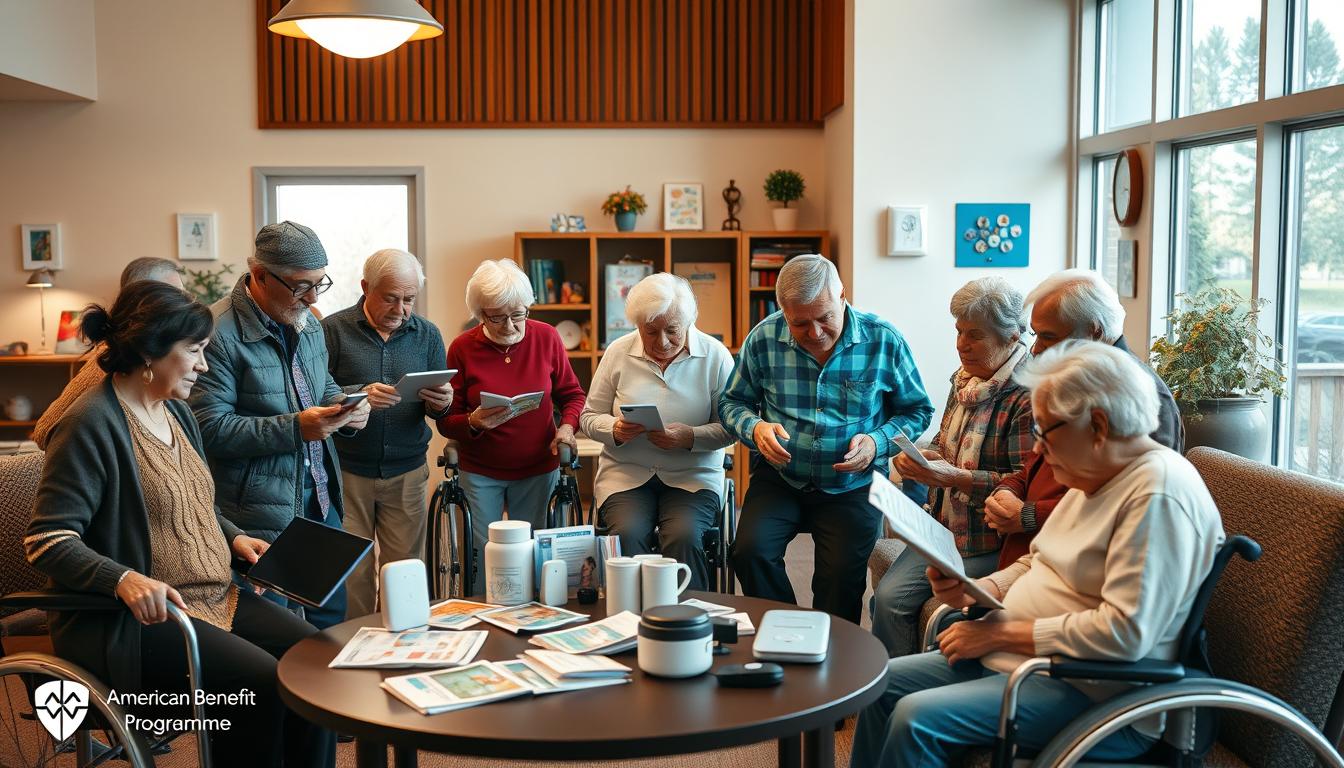Have you ever thought about the challenges our elderly face living on their own? Many older adults choose to stay at home as they age. It’s important to know their safety needs. Older people face dangers like falling, burns, or poisonings. Living alone can also make them easy targets for crime12. Our guide gives helpful advice and tips for seniors and their helpers. It helps make the US safer for our senior citizens.
We’ll share key info on making homes safer for older adults. This guide talks about fixing homes, being ready for emergencies, and important safety additions. Knowing about dangers and how to prevent them is our goal. This way, we can keep our beloved seniors safe and happy.
Key Takeaways
- Understanding common risks and safety needs for seniors is fundamental in enhancing their well-being.
- Creating a safe home environment reduces the likelihood of accidents.
- Emergency preparedness is crucial for older adults living independently.
- Preventing falls through home modifications and exercise programs is key.
- Utilizing senior safety resources can greatly improve the living conditions of elderly individuals.
- Financial awareness is necessary to safeguard against abuse and scams targeting older adults.
Understanding Senior Safety Needs
It’s vital to know what dangers seniors face to keep them safe. They deal with common risks for seniors that change their lives. This knowledge helps those who care for them to make things safer.
Common Risks Faced by Older Adults
Many seniors, nearly 29%, fall each year. That’s over 15 million of them3. Falls mostly happen at home, about 43% to 60% of the time3.
Bedrooms are often where these falls occur, about 33%3. Slipping and tripping causes about 64% of falls3. Also, 10 million seniors struggle to move around3. We need better aging safety resources.
The Importance of Awareness in Senior Safety
Knowing about dangers helps fight things like loneliness and scams4. Resources can help seniors handle new challenges and costs4. Recognizing risks lets them get help and use community support.
Groups like the National Council on Aging help with money matters amid dangers4.
Creating a Safe Home Environment
Making homes safe for seniors helps stop falls and injuries. It’s important to make changes for fall prevention modifications. Sadly, the U.S. Census Bureau finds only 10% of homes are ready for aging folks. And nine out of 10 homes miss one key feature for elder care5. Adding smart changes protects seniors and helps them live on their own.
Home Modifications for Fall Prevention
There are tips to help stop falls at home:
- Remove things you can trip over, like loose rugs and mess.
- Make sure the house is well-lit.
- Put grab bars in bathrooms and near steps.
- Use non-slip mats in places like kitchens and bathrooms.
Most falls happen in the bedroom, stairs, and bathroom5. Make these changes to keep safe.
Choosing Non-Slip Flooring Options
A good way to stop falls is to use non-slip flooring for seniors. Use floors like textured vinyl or rubber. They are less slippery. The stairlift market is growing. It will get bigger by 9.1% from 2023 to 2030. This shows more people want safer homes5. Picking the right floors and making homes safer lets seniors stay independent and safe.
If you live around St. Louis City and County, or Webster Groves, help is there. Senior Helpers6 can help make homes safer. They can install grab bars, non-slip mats, and other things to make homes safe for seniors.
Emergency Preparedness for Seniors
It’s very important for seniors to be ready for emergencies. By making a good plan and keeping contact info close, they will be better prepared. A safety checklist for seniors helps with this preparation.
Keeping Emergency Numbers Handy
Seniors need a list of important phone numbers. This list should have numbers for local emergency services, family, healthcare providers, and help lines. It’s important to keep this list where you can see it. This helps seniors act fast in emergencies. They should make sure someone they trust has a key and knows about their emergency stuff and medical needs. For tips on making emergency plans, look at this resource.
Planning for Natural Disasters and Evacuations
Seniors must plan for evacuations because of natural disasters. Knowing which disasters might happen helps seniors prepare better. They should make plans that include where to go, what to bring, and how to stay in touch. Working with local services to understand their plans helps too. CAL FIRE7 gives good advice on making plans for seniors with special needs during a crisis. A disaster guide might show simple steps like assessing needs and having a strong support group8
Talking with family, friends, and caregivers helps make a stronger support network. This means seniors can get help fast in an emergency. Planning for pets or service animals is important too, since not all places can take them. Seniors should also keep copies of their insurance cards safe and ready to use9.
| Emergency Preparedness Steps | Task | Frequency |
|---|---|---|
| Assess Needs | Identify personal and medical needs | Annually |
| Create a Plan | Outline evacuation routes and essential contacts | Bi-annually |
| Build Support Network | Engage friends and family | Ongoing |
| Check Emergency Supplies | Verify the status and location of supplies | Every 6 months |
| Review Insurance | Ensure all documents are current and accessible | Annually |
Preventing Falls in the Home
Keeping older adults safe at home means stopping falls. Many falls happen where people live most10. To lower falls, keep walking paths clear, secure rugs, and use mats that don’t slip. Handrails by stairs help a lot too10. Also, lights that turn on by themselves are key in dark areas10. Floors made of tile or wood should have non-slip strips10.
Implementing Safety Measures
Important safety steps are:
- Putting grab bars near toilets and showers helps stop falls10.
- Non-slip mats in wet spots reduce slipping chances10.
- Having lights at night in bathrooms for safety10.
- Night lights and flashlights are key for bed safety10.
- Wearing a pendant to call 911 after a fall is smart10.
- Experts can check homes for fall dangers10.
Exercise Programs to Enhance Balance
Exercises that improve balance are key for older folks. These workouts make them stronger and more flexible11. This helps them stay independent by falling less11. Wear safe shoes and keep your home bright to see everything11.
Senior Safety Resources for Home
Today, technology helps keep seniors safe at home. It offers tools that make their lives safer. This is good for seniors and their families. Knowing about these tech tools is key to a safe home.
Home Security Systems and Technology
Security systems are vital for senior safety. They have cameras, alarms, and motion sensors. These systems are easy for seniors to use. Smart devices also check for fire or gas and call for help if there’s danger. This helps keep seniors safe at home.
Medical Alert Devices for Instant Assistance
Medical alert devices are important for seniors. They can ask for help easily, anytime. Some devices signal for help if a senior falls. This quick help can save lives, making these devices crucial.
Telling seniors about these tools and making them easy to use is important. It helps them stay safe and independent. Using technology in senior care is key for their safety and happiness121314.
Staying Safe in the Kitchen
The kitchen is a busy place, especially for older adults. They cook meals for themselves and their families. It’s important to stay safe. Knowing the dangers can help avoid them. This is key to stopping kitchen fires and keeping things neat.
Fire Hazards and Prevention in Cooking
Cooking is a big cause of fires at home. More than half of fires start in the kitchen15. To stop fires, keep things that can burn away from hot spots. Make sure your appliances work well. Change the batteries in your smoke alarm every six months to be safer16. Clean the fan over your stove once a year. This stops grease from starting fires16. Older people must be careful with hot things to avoid burns. Every year, hot liquids burn nearly 500,000 people in the country15.
Kitchen Organization Tips to Avoid Accidents
How you arrange your kitchen can keep you safe. Keep things you use a lot where you can easily get them. This way, you don’t have to stretch or bend too much. Stretching or bending can make you fall, especially in the kitchen. Properly storing food is also key. It keeps you healthy and your kitchen in order. Using sharp knives is actually safer. They give you more control when you cut, which means fewer accidents15.

For safer meal prep, put nightlights with motion sensors in your kitchen. This lights up paths at night16. Making the kitchen safe for older adults lets them enjoy cooking without worry.
Bathroom Safety Tips for Seniors
Bathrooms can be risky for older people. They need special rules to stay safe. By avoiding falls, they can keep from getting hurt. This lets them bath without fear.
Essential Installations for Fall Prevention
Putting up grab bars near toilets and tubs helps a lot. Most bathroom falls happen near bathtubs or showers17. This shows why help is crucial there. Raised toilet seats boost safety too. They make sitting down and getting up easier17. Also, swap out big bath mats for strips that don’t slip17.
- Install wall-mounted grab bars for better support.
- Use shower and bath chairs to enhance stability.
- Keep bathrooms tidy to prevent clutter-related falls.
Water Temperature Regulations to Prevent Scalding
Regulating water temperature helps prevent burns. Setting the heater to 120 degrees or less is advised18. This step cuts down burn chances. Since elders and kids are most at risk, it’s key18. With many elders falling each year, safe baths are crucial18.
Senior Safety Checklist
Making a senior safety checklist is very important. It helps keep older people safe at home. Daily safety tips for seniors can greatly lower the chances of accidents.
Daily Checklist for at-home Safety
Begin each day by checking the home for safety. Make sure walkways are clear. Also, fix any dangers like loose rugs or cords to stop falls. One in four seniors fall each year19.
Also, check the lights often, making them brighter if needed. Even light without glare is very important for safety and comfort20.
Regular Safety Audits of Living Space
Do home safety checks often to see if safety steps work well. Check things like smoke alarms and carbon monoxide detectors. About 80% of falls happen in the bathroom, so install grab bars there. Stairs should have good lighting and strong handrails2019.
Senior Safety Programs Available
Keeping older adults safe takes everyone working together and having good resources. There are many community safety programs for seniors. They give tools and teach important things to keep them safe every day. These programs focus on common dangers and share key tips on safety and health.
Community Programs and Resources
Many local areas offer great safety programs for seniors. In North Dakota, those over 60 have ND Assistive’s Senior Safety Program. It has things like wandering alarms, medication dispensers, grab bars, and shower heads21. These help prevent falls, which affect 1 in 3 seniors each year22.
Many say these programs really help. For example, a 93-year-old grandmother is living well on her own thanks to these tools21.
Online Resources for Senior Safety Education
Today, online safety resources are key for teaching seniors how to be safe. They can find many helpful things online, like articles and webinars. These cover topics like avoiding falls and how to take medicine right. Not taking meds right causes 25% of hospital visits for those 65 and up22. So, learning correctly is very important.
With online learning, seniors and those who care for them can stay up to date. They can learn important safety tips anytime, anywhere.
| Program Type | Services Offered | Eligibility Criteria |
|---|---|---|
| ND Assistive’s Senior Safety Program | Wandering alarms, medication dispensers, grab bars | North Dakotans over 60 |
| Online Safety Resources | Articles, webinars, educational materials | Open to all seniors |
| Community Workshops | Safety education, fall prevention strategies | Varies by community |
Protecting Seniors Against Financial Abuse
Financial abuse is a big worry for older adults. More seniors are reaching retirement these days. Over 10,000 Americans turn 65 every day. This makes the risk of money scams bigger23. It’s very important for seniors and their helpers to know how to spot scams. They must protect their personal info to avoid financial harm.
Recognizing Scams Targeting Older Adults
Scammers often target older people because they trust easily. They might not think as clearly and they have saved a lot of money24. Every year, millions of seniors lose billions to scams23. Look out for strange bank activities or sudden changes in how they spend.
- Unusual bank account activity
- Sudden changes in spending habits
- Suspicious signatures on checks
Telling seniors how to recognize scams is key. Programs that teach about money safety can really help25.
How to Safeguard Personal Information
Keeping personal info safe helps prevent money scams against seniors. Shredding old papers and checking credit reports helps a lot25. Seniors can get a free credit report once a year from three big agencies24. If they think a scam is happening, they should tell protective services and the police right away24.
Banks and other money places can help protect seniors too. They can stop transactions if they think something’s wrong23. Having someone trusted to help with money can add extra safety23.

| Preventive Measures | Actions | Resources |
|---|---|---|
| Credit Monitoring | Order annual credit reports | Major Credit Bureaus |
| Document Security | Shred sensitive documents | Local Shredding Services |
| Financial Vigilance | Watch for unusual account activity | Financial Advisors |
| Reporting | Contact authorities if scams are suspected | Local Police, Adult Protective Services |
Being smart and cautious can really help seniors. They can stay safe from scams and protect their information better.
Resources for Caregivers
Caregivers play an essential role in caring for seniors. Getting to caregiver resources can really help them. These resources offer great support for family caregivers and training.
Support and Training for Care Providers
Many caregivers get help from support groups. This includes help from both local and national organizations. For example, services help find local resources like in California’s Caregiver Resource Centers26. There, they guide on adult day care and meals.
The Family Caregiver Support Program in Washington helps unpaid caregivers27. It gives them the resources they need. This is key for giving training and tips to caregivers.
Tools and Resources for Family Caregivers
There are many tools to help family caregivers. For instance, AARP’s meal delivery offers 25% off on first orders over $9928. Programs care for various health conditions. And, there are cheaper travel options for seniors26.
Online sites like CareLearn Washington and Trualta provide great training27. They teach caregivers how to give good care to the elderly.
Conclusion
Senior safety resources are very important for older adults. These resources help keep them safe as more need help each year. Ensuring a safe home and warning about risks and scams are key parts.
It’s key that seniors live in a secure place to keep their independence and health. Making homes safer and knowing about scams helps a lot. Sadly, half of older adults who struggle daily get no help29.
This shows we need more help and resources for them. As elder care changes, families and caregivers must stay alert. They should always look for ways to make things safer for seniors.
Creating a caring and informed community is huge. Sharing info on senior safety and using resources can protect them. This lets our elders enjoy a safe space at home and around others3031.
Source Links
- Home Safety Tips for Older Adults
- Aging in Place: Growing Older at Home
- Room-by-Room Guide to Senior Home Safety | SafeWise
- Resources for Aging Adults and Their Families – National Library Service for the Blind and Print Disabled (NLS) | Library of Congress
- Creating a Safe and Accessible Home Environment for Seniors
- How to Create a Safe and Comfortable Home Environment for Seniors
- Emergency Preparedness & Response – Helpful Tools & Tips | California Department of Aging
- Older Adults | Ready.gov
- Emergency Preparedness | ACL Administration for Community Living
- Preventing Falls at Home: Room by Room
- Fall prevention: Simple tips to prevent falls
- Services & Resources – NJAAW – New Jersey Advocates for Aging Well
- Senior Citizen Safety Tips – Nationwide
- Senior Safety Products | Products To Help Seniors Live Safely at Home
- A Guide to Safety in the Kitchen – StaySafe.org
- Keeping the Kitchen Safe for Seniors – Home Helpers Home Care
- 7 Bathroom Safety Tips for Seniors
- How Can You Make a Bathroom Safe for the Elderly?
- Comfort Keepers of Delaware
- A Home Safety Checklist for Seniors
- Senior Safety Program – North Dakota Assistive
- 11 Elderly & Senior Safety Tips & Tools | Lifeline ®
- Protecting Seniors From Financial Exploitation
- Protecting Seniors from Financial Abuse
- No title found
- A Guide to Community Resources
- Caregiver Resources | DSHS
- AARP Resources for Caregivers and their Families
- Understanding the care and support needs of older people: a scoping review and categorisation using the WHO international classification of functioning, disability and health framework (ICF) – BMC Geriatrics
- FACT SHEET: Protecting Seniors by Improving Safety and Quality of Care in the Nation’s Nursing Homes | The White House
- Seniors Guidebook to Safety and Security

Leave a Reply